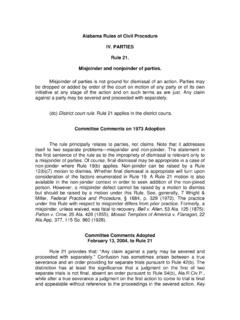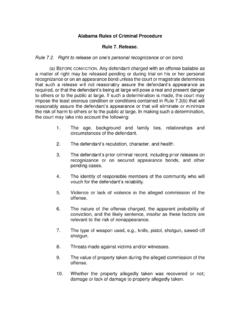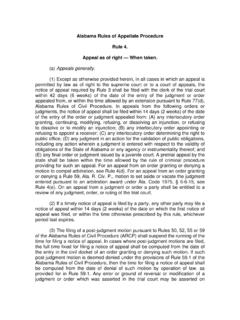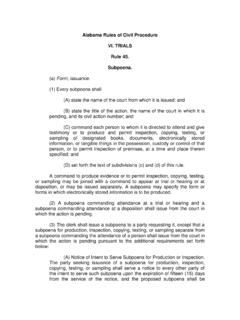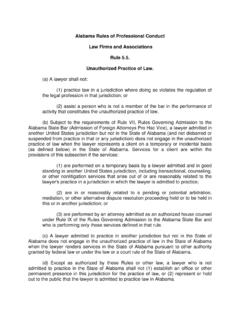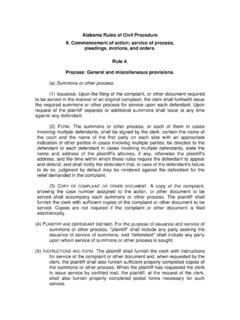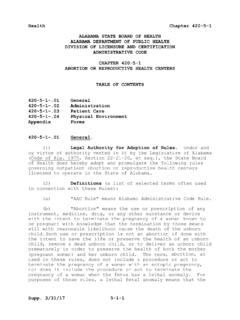Transcription of Ala. Code 1975, § 26-15-3.2 ... - judicial.alabama.gov
1 Ala. code 1975 , Chemical Endangerment of a Child The defendant is charged with chemical endangerment of exposing a child to an environment in which controlled substances are produced or distributed. A person commits the crime of chemical endangerment of exposing a child to an environment in which controlled substances are produced or distributed if he/she is a responsible person and knowingly, recklessly, or intentionally causes or permits a child to be exposed to, to ingest or inhale, or to have contact with a controlled substance, chemical substance, or drug paraphernalia. To convict, the State must prove beyond a reasonable doubt each of the following elements: (1) The defendant was a responsible person, [describe]; (AND) (2) The defendant caused or permitted a child, [insert name]: [Read all appropriate] (A) To be exposed to; (B) To ingest or inhale; (OR) (C) To have contact with; A controlled substance, chemical substance, or drug paraphernalia, [describe]; (AND) (3) The defendant did so knowingly, recklessly, or intentionally.
2 [Read all appropriate]; (AND) (4) A child suffered serious physical injury by exposure to, ingestion of, inhalation of, or contact with a controlled substance, chemical substance, or drug paraphernalia. (AND) (5) The exposure, ingestion, inhalation, or contact with a controlled substance, chemical substance, or drug paraphernalia resulted in the death of the child. A responsible person is a child's natural parent, stepparent, adoptive parent, legal guardian, custodian, or any other person who has the permanent or temporary care or custody or responsibility for the supervision of a child. [ 26-15-2(4)] A child is a person who is less than 18 years of age. [See 26-15-3 & 26-14-1(3).] A controlled substance is a drug, substance, or immediate precursor in Schedules I through V, as provided in 20-2-20 et seq.
3 , Ala. code 1975 . [ 20-2-2(4)] [Read As Appropriate] Drug paraphernalia means all equipment, products, and materials of any kind which are used, intended for use, or designed for use, in planting, propagating, cultivating, growing, harvesting, manufacturing, compounding, converting, producing, processing, preparing, testing, analyzing, packaging, repackaging, storing, containing, concealing, injecting, ingesting, inhaling, or otherwise introducing into the human body a controlled substance in violation of the controlled substances laws of this state. It includes but is not limited to: [Read all appropriate] a. Kits used, intended for use, or designed for use in planting, propagating, cultivating, growing, or harvesting of any species of plant which is a controlled substance or from which a controlled substance can be derived; b.
4 Kits used, intended for use, or designed for use in manufacturing, compounding, converting, producing, processing, or preparing controlled substances; c. Isomerization devices used, intended for use, or designed for use in increasing the potency of any species of plant which is a controlled substance; d. Testing equipment used, intended for use, or designed for use in identifying, or in analyzing the strength, effectiveness, or purity of controlled substances; e. Scales and balances used, intended for use, or designed for use in weighing or measuring controlled substances; f. Dilutants and adulterants, such as quinine hydrochloride, mannitol, mannite, dextrose and lactose, used, intended for use, or designed for use in cutting controlled substances; g.
5 Separation gins and sifters used, intended for use, or designed for use in removing twigs and seeds from, or in otherwise cleaning or refining, marihuana; h. Blenders, bowls, containers, spoons and mixing devices used, intended for use, or designed for use in compounding controlled substances; i. Capsules, balloons, envelopes and other containers used, intended for use, or designed for use in packaging small quantities of controlled substances; j. Containers and other objects used, intended for use, or designed for use in storing or concealing controlled substances; k. Hypodermic syringes, needles and other objects used, intended for use, or designed for use in parenterally injecting controlled substances into the human body; l.
6 Objects used, intended for use, or designed for use in ingesting, inhaling, or otherwise introducing marihuana, tetrahydro cannabinols, cocaine, hashish, or hashish oil into the human body, such as: 1. Metal, wooden, acrylic, glass, stone, plastic, or ceramic pipes with or without screens, permanent screens, hashish heads, or punctured metal bowls; 2. Water pipes; 3. Carburetion tubes and devices; 4. Smoking and carburetion masks; 5. Roach clips: Meaning objects used to hold burning material, such as a marihuana cigarette, that has become too small or too short to be held in the hand; 6. Miniature cocaine spoons, and cocaine vials; 7. Chamber pipes; 8. Carburetor pipes; 9. Electric pipes; 10. Air-driven pipes; 11.
7 Chillums; 12. Bongs; 13. Ice pipes or chillers; 14. Glass tubes which are hollow, cylindrical items made of glass which are smaller than three-quarters of an inch in diameter, shorter than 12 inches in length, and which are not sealed with glass at both ends. In determining whether an object is drug paraphernalia, a court or other authority shall consider, in addition to all other logically relevant factors, the following: [Read All Appropriate] a. Statements by an owner or by anyone in control of the object concerning its use; b. Prior convictions, if any, of an owner, or of anyone in control of the object, under any state or federal law relating to any controlled substance; c. The proximity of the object, in time and space, to a direct violation of this section or to a controlled substance; d.
8 The existence of any residue of controlled substances on the object; e. Direct or circumstantial evidence of the intent of an owner, or of anyone in control of the object, to deliver it to persons whom he knows intend to use the object to facilitate a violation of the controlled substances laws of this state; the innocence of an owner, or of anyone in control of the object, as to a direct violation of such laws shall not prevent a finding that the object is intended for use, or designed for use as drug paraphernalia; f. Instructions, oral or written, provided with the object concerning its use; g. Descriptive materials accompanying the object which explain or depict its use; h. National and local advertising concerning its use; i.
9 The manner in which the object is displayed for sale; j. Whether the owner, or anyone in control of the object, is a legitimate supplier of like or related items to the community, such as a licensed distributor or dealer of tobacco products; k. Direct or circumstantial evidence of the ratio of sales of the object or objects to the total sales of the business enterprise; l. The existence and scope of legitimate uses for the object in the community; m. Expert testimony concerning its use. [ 13A-12-260] [Read as appropriate] Serious physical injury is physical injury which creates a substantial risk of death, or which causes serious and protracted disfigurement, protracted impairment of health, or protracted loss or impairment of the function of any bodily organ.
10 [ 13A-1-2(14)] [Read as appropriate] Physical injury is impairment of physical condition or substantial pain. [ 13A-1-2(12)] A person acts intentionally with respect to a result or to conduct described by a statute defining an offense, when his/her purpose is to cause that result or to engage in that conduct. [ 13A-2-2(1)] A person acts knowingly with respect to conduct or to a circumstance described by a statute defining an offense when he/she is aware that his/her conduct is of that nature or that the circumstance exists. [ 13A-2-2(2)] A person acts recklessly with respect to a result or to a circumstance described by a statute defining an offense when he/she is aware of and consciously disregards a substantial and unjustifiable risk that the result will occur or that the circumstance exists.



